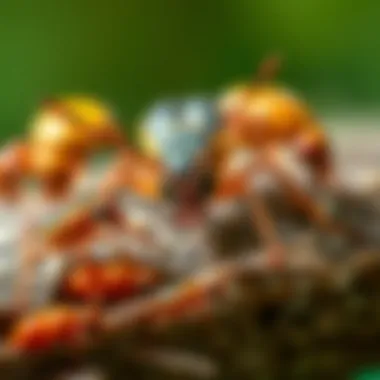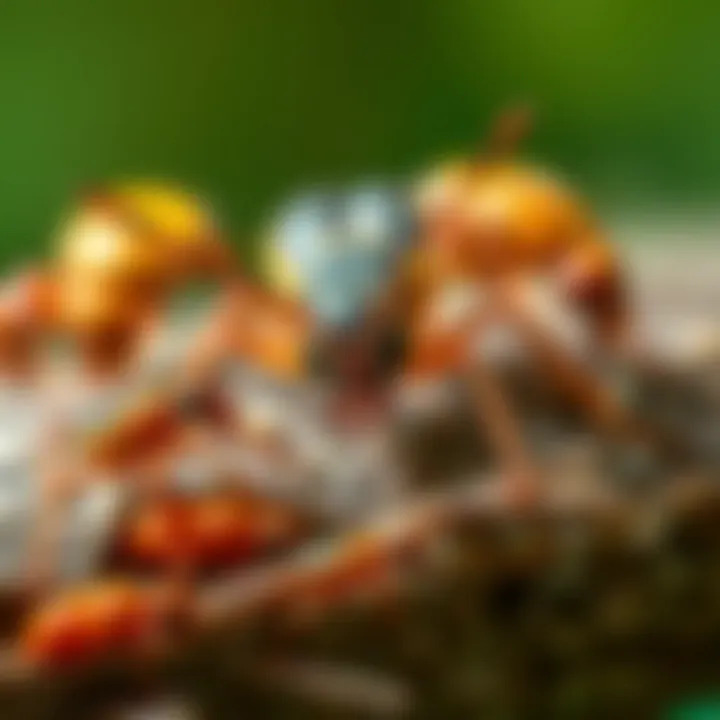Comprehensive Guide to Pest Control in Crestview, FL


Intro
In the sunny landscapes of Crestview, Florida, pest control represents a crucial aspect of maintaining a healthy living environment. Homeowners find themselves grappling with unwelcome visitors – from cockroaches scuttling in kitchen corners to termites silently munching away at the very structure of the house. No one wants these intruders setting up shop, and that's where professional exterminator services step in.
Understanding the types of pests that are prevalent in Crestview is the first step. This guide aims to empower homeowners with essential pest management strategies. Through a detailed examination of pest identification, prevention techniques, and treatment options, you will gain insights tailored specifically for this region. Armed with this knowledge, homeowners can make informed decisions, ensuring that their homes remain safe, pest-free sanctuaries.
Pest Identification
Detailed Descriptions of Common Pests
Crestview is home to a variety of pests that can wreak havoc if left unchecked. Here's a closer look at some of the most common culprits:
- Termites: Known as the silent destroyers, these insects can cause significant structural damage. They prefer moist, decaying wood and often go unnoticed until it's too late.
- Ants: Particularly, the Argentine ant and fire ant species are common in this area. They invade homes in search of food and shelter, and some, like fire ants, can deliver painful stings.
- Cockroaches: The American and German cockroaches flourish in warm, humid environments. They are nocturnal and often found in kitchens and bathrooms, spreading bacteria as they scavenge for food.
- Rodents: Mice and rats are notorious for entering homes, seeking food and warmth. Their droppings can contaminate food sources and introduce disease.
Signs and Symptoms of Infestations
Detecting a pest issue early can save homeowners a world of trouble. Here are key indicators to watch for:
- Visual Sightings: Spotting a live pest is the most direct sign. Ant trails or a sudden increase in cockroach sightings can be alarming.
- Droppings: Finding small feces in drawers or under sinks typically points to rodents. Similarly, insect droppings vary in shape but are usually small and dark.
- Damage: Look for gnaw marks on wood, signs of holes in walls, or chewed wires which could signal rodent activity. Pest-induced damage may often be the first visible sign of an infestation.
Understanding these signs quickly can make all the difference in controlling a pest issue before it escalates.
Prevention Strategies
Home Maintenance Tips for Pest Prevention
While it’s never a pleasant thought, preventing pests from entering your home is a vital part of home maintenance. Here are some effective strategies:
- Seal Cracks: Small gaps in foundations, windows, and doors are easy entry points. Caulking these gaps can keep pests out.
- Regular Cleaning: Keeping a clean home, especially in kitchen areas, can deter pests. Crumbs, spills, and standing water can attract unwanted guests.
- Outdoor Maintenance: Trim shrubs and trees around your home. Overhanging branches can serve as bridges for pests to enter your domicile.
Natural Deterrents and Barriers
Many homeowners are looking for eco-friendly options for pest deterrence. Consider these natural remedies:
- Essential Oils: Spraying a mixture of water and oils like peppermint or tea tree oil can repel ants and spiders.
- Diatomaceous Earth: This powder can be spread around problematic areas. It’s non-toxic and kills insects by damaging their exoskeletons.
- Homemade Traps: Simple traps using vinegar, sugar, or baking soda can effectively catch common house pests like fruit flies.
Treatment Options
Overview of Chemical vs. Natural Treatments
The choice between chemical and natural pest treatments often depends on the severity of the infestation. Chemical solutions tend to offer rapid results, while natural remedies may require consistent application over time. It's important to be aware of your household's specific pest problems to select the best course of action.
Step-by-Step Guides for DIY Treatments
For homeowners wishing to tackle pest issues head-on, do-it-yourself methods can be effective. Here’s how to approach a few common scenarios:
- For Ants: Mix equal parts vinegar and water in a spray bottle. Apply this solution directly to ant trails to eliminate and deter them from returning.
- For Cockroaches: Create a bait with one part baking soda and one part sugar. Place it in areas where cockroaches are seen. The sugar attracts them, while the baking soda helps to eliminate them.
- For Termites: If you suspect termites, try using a mixture of borate and water to treat wood surfaces.
A combination of proactive maintenance, informed pest identification, and effective treatments can go a long way in pest management. Homeowners in Crestview, by taking these steps, can keep their homes free from unwanted critters, turning a potential panic into a manageable task.
Understanding Pest Problems in Crestview
Comprehending pest issues in Crestview is key to maintaining a comfortable and safe living environment. The region's unique characteristics can lead to a range of pest problems that homeowners must address. Awareness of local pest dynamics is beneficial; it enables residents to take proactive measures rather than react in crisis.
Residents often find themselves battling against unwanted insects and rodents which can cause structural damage or health risks. By understanding these problems, individuals can make informed decisions, potentially saving money on repairs and pest control services. Knowledge acts as the first line of defense against potential infestations.
Common Pests in the Region
Pests Typically Found in Crestview
Crestview is home to a variety of pests, each with unique characteristics that make them noteworthy. For instance, termites are notorious in this area, creating havoc by silently munching through the wooden structures of homes. This is alarming since their presence can go undetected until significant damage has occurred.
Another common pest is the American cockroach, which thrives in warm, humid environments.
- Key Characteristics:
- Termites can silently damage homes over months, making them particularly dangerous.
- The American cockroach is easily recognizable due to its large size and fast-moving behavior.
These pests are not just a nuisance; they can jeopardize property and health if not controlled. Their prevalence in Crestview underscores the need for effective pest management strategies.
Seasonal Fluctuations in Pest Activity
Pest activity in Crestview isn't static; it shifts with the seasons. During warmer months, pests like mosquitoes and ants become more active.
- Key Characteristics:
- Mosquito populations often explode during summer due to breeding conditions created by warmth and moisture.
- Conversely, colder seasons often see a reduction in species such as ants, but rodents may invade homes as they seek warmth.
Understanding these patterns allows homeowners to time their pest control measures effectively, creating a significant advantage in preventing infestations.
Impact of Local Climate on Pest Proliferation
The climate in Crestview plays a pivotal role in determining which pests thrive. The humid subtropical climate offers a perfect breeding ground for many pests. For example, the moisture levels associated with Florida's humidity create ideal conditions for pests like termites and bed bugs.
- Key Characteristics:
- The humid conditions encourage rapid reproduction of pest populations.
This interaction between climate and pests underscores the importance of tailored pest management solutions that consider the specific local environment. By addressing climate-related pest proliferation, homeowners can create strategic plans to combat infestations before they arise.
The Role of an Exterminator
Understanding the role of an exterminator is crucial for homeowners facing pest issues in Crestview. Exterminators are skilled professionals trained to assess, treat, and monitor pest infestations effectively. Their expertise not only offers immediate solutions but also equips homeowners with strategies to prevent future pests from invading their homes. Ultimately, hiring an exterminator can be a wise investment rather than a mere expense, significantly contributing to maintaining a healthy living environment.


What Does an Exterminator Do?
Assessment of Infestation
When an exterminator comes to assess an infestation, they look for specific signs indicative of pest activity. This step is vital, as it provides a clear picture of the severity and type of pest problem. One key characteristic of this assessment is the thorough inspection covering various areas, including basements, attics, and even the backyard. This comprehensive examination is a popular choice for homeowners, offering benefits such as precise identification of pests and tailored treatment options.
However, on the flip side, assessments may vary in cost depending on the extent of the infestation, which can sometimes catch homeowners by surprise. Still, the unique advantage is that an accurate assessment can save money down the line by preventing over-treatment or misdiagnoses, effectively addressing the immediate concerns.
Implementation of Treatment Plans
Following the assessment, an exterminator will design and implement a tailored treatment plan to address the specific infestation condition. This plan often combines different strategies ranging from chemical treatments to natural solutions. One of the notable characteristics is how customized these plans can be, taking into account the types of pests found, the extent of damage, and the homeowner's preferences.
This approach is particularly beneficial in Crestview, where different pests require different treatment strategies. The unique feature of customized treatment plans allows for a more focused and effective approach in tackling the problem. However, while most plans aim for efficacy, they can sometimes require multiple visits or treatments, translating to more time and investment before noticing results.
Ongoing Monitoring and Prevention
An often overlooked aspect of an exterminator’s role is the focus on ongoing monitoring and prevention post-treatment. Once an initial treatment plan is in place, many professionals will set up follow-up appointments to ensure that the pests do not return. The key characteristic of this strategy is the proactive measures taken to identify potential future problems before they escalate.
This continuous approach is especially beneficial as it grants homeowners peace of mind, knowing that they have support in maintaining a pest-free environment. The unique benefit of ongoing monitoring lies in the potential for adjustments to treatment strategies tailored to seasonal changes and new pest behaviors.
However, it may also mean a commitment to continued services, which requires understanding the long-term commitment involved. That said, the investment often pays off as it can prevent future infestations.
Types of Exterminators
Residential Pest Control Specialists
Residential pest control specialists focus on household pest issues. Their expertise covers a range of household pests, from ants to rodents. They are often familiar with local pest trends, a vital aspect for effectively addressing the needs of Crestview residents. Most notable is their hands-on approach, which often includes personalized consultations to understand clients' unique situations.
However, one disadvantage is that their specialization may lead to higher costs compared to general pest control services. Still, the unique benefit lies in their thorough understanding of residential pest behaviors and environmental factors, so they can provide targeted and effective solutions.
Commercial Pest Management Experts
Commercial pest management experts cater to businesses, ensuring compliance with health and safety regulations while managing pest issues. They typically handle larger spaces with different pest populations, which makes their expertise crucial for restaurants, office buildings, and warehouses. Their key characteristic is their ability to design pest management plans that can minimize disruptions to business operations.
Given the stakes, these specialists often provide rapid service aimed at minimizing downtime. However, some may find their pricing can vary significantly based on the type of business and the size of the operation. Nevertheless, the advantage is their specialized knowledge can lead to quicker resolutions, saving businesses from potential losses due to pest-related problems.
Eco-Friendly Exterminators
Eco-friendly exterminators focus on using natural and environmentally friendly methods to control pest issues. This includes the use of organic pesticides and strategies aimed at minimizing environmental impact. Their key characteristic is their commitment to sustainable practices, which appeals to many homeowners concerned about chemical exposure and their ecological footprint.
The unique feature that eco-friendly exterminators offer is the integration of holistic approaches, such as improving habitat and using biological controls. While this can sometimes be a slower process compared to traditional methods, the long-term benefits can be immense. These include enhanced safety for children and pets and a healthier environment overall. The downside is the effectiveness of natural solutions may vary based on pest type, which could mean they are sometimes not suitable for widespread infestations.
Through understanding the role and types of exterminators, homeowners in Crestview can make informed decisions, ensuring they choose the right professional to meet their pest control needs.
Identifying a Pest Infestation
Identifying a pest infestation is a crucial step in maintaining a healthy home environment. Understanding the signs of pest problems is essential. The sooner homeowners can detect unwanted guests, the better their chances of controlling the situation effectively. Ignoring early indicators can lead to more serious issues, requiring more extensive and costly measures. Thus, knowing what to look for is not just beneficial, it’s necessary.
Signs of Infestation
Visible Pests and Their Habitats
One of the first signs homeowners may notice are the pests themselves. Whether it’s a roach scuttling across the floor or a termite swarming around wooden structures, spotting these creatures can prompt quick action. Each pest has its preferred habitat, which often provides clues about their presence. For example, ants may trail along kitchen counters while termites often appear near wooden beams.
A key characteristic of visible pests is that they can be the first warning bells about a larger infestation. Their presence indicates that a suitable environment exists for breeding and feeding, thus amplifying the urgency for control. The unique feature about visible pests is their varied appearance; from color to size, each pest presents different identifiers. Understanding these can aid in early recognition of bigger issues brewing.
Advantages include immediate awareness, which can lead to faster pest control solutions. Disadvantages may arise with misidentification; a homeowner might mistake an innocuous insect for a harmful one, leading to unnecessary panic or inappropriate treatment methods.
Damage to Property
Often, the signs of infestation are not just what you can see but also what you can observe through property damage. Undefined marks, wood shavings, or unusual bite marks on surfaces can signify that pests are hard at work. For instance, termites and carpenter ants can be particularly damaging; they eat through wood and create hidden tunnels, weakening structural integrity.
The key characteristic of property damage is that it reveals the extent of the pest problem. While exterior signs like traps or bait stations signal a need for intervention, internal damage provides a stark realization of how invasive these pests can be. Builders and pest control experts stress that property damage should never be underestimated—it can often lead to very expensive repairs.
The unique feature of property damage is that it often requires immediate action. Noticing wear and tear can lead homeowners to seek help sooner rather than later, saving them time and money. However, a disadvantage lies in the potential lag in response; unless damage is observed, many may remain oblivious to an ongoing infestation, causing it to worsen.
Unusual Noises or Odors
At times, the signs of a pest infestation can be auditory or olfactory rather than visual. Scratching noises in walls or unusual smells often indicate hidden pests. This can particularly be the case with rodents. If a home is silent one minute and filled with strange sounds at night, something may be amiss. As for odors, decaying pests can produce an unmistakable smell, alerting homeowners to an issue.
The key characteristic of unusual noises or odors is their subliminal warning—often, you may not see the culprit but will hear or smell them instead. These signals can spur early intervention and provide clues about what kind of infestation one might be dealing with. One unique feature of this aspect lies in its subjective nature; sounds vary greatly and may sometimes be dismissed as normal home noises, leading to longer-term infestations.
The benefits of being attuned to these signs can be two-fold: early detection and the ability to strategize a more effective treatment plan. On the flip side, there’s a risk of alarm over misinterpreted sounds or scents, leading homeowners to react prematurely or ineffectively.
Understanding the signs of a pest infestation can save time, money, and frustration in the long run. Staying vigilant pays off when it comes to home maintenance.
Preventing Pest Infestations
Preventing pest infestations is a crucial aspect of maintaining a healthy home environment. In Crestview, the humid subtropical climate provides an ideal breeding ground for pests. By taking proactive measures, homeowners can reduce the likelihood of insects and rodents invading their spaces. This section discusses effective practices and landscaping strategies that can prevent pest issues before they begin.
Best Practices for Homeowners
Sealing Entry Points
Sealing entry points is like locking the door to your house—it's a frontline defense in pest control. Small gaps around doors, windows, and even utility lines can serve as highways for unwanted critters. By utilizing caulk and weather stripping, homeowners can effectively block these pathways. Not only does this reduce the risk of an infestation, but it can also help improve your home’s energy efficiency. A well-sealed home keeps hot air out during the summer and retains warmth in winter, making it a two-for-one deal in terms of benefits.
However, homeowners should be vigilant in their checks; sometimes, it’s the tiniest holes that allow the biggest pests in.
Proper Waste Management
Practicing proper waste management is another pivotal step. Keeping trash bins tightly sealed and disposing of waste regularly minimizes food sources for pests. A clean yard and kitchen discourage critters from settling in, as they thrive in environments where food is readily accessible. Use plastic containers with secure lids to make it harder for pests to get a meal. This approach not only keeps your environment tidy but also saves you the hassle of dealing with pest issues down the line.
Remember, a clean home is a pest-free home, and simple actions can lead to significant outcomes.


Maintaining a Clean Environment
Maintaining a clean environment goes hand-in-hand with pest prevention. Regular cleaning routines that focus on hidden areas such as behind appliances, under sinks, and in attics can reveal potential pest issues before they escalate. Dust, crumbs, and spills provide an inviting atmosphere for a variety of pests.
Incorporating cleaning into your regular schedule helps mitigate the risk of invasions. It’s beneficial, too, because a tidy space contributes to overall wellness.
Role of Landscaping in Pest Prevention
The landscaping around your home can either attract or deter pests. By being thoughtful about plant selection and placement, you can create a barrier against common invaders.
Choosing Pest-Resistant Plants
Choosing pest-resistant plants is a smart move. Some flora naturally repel insects. For instance, marigolds and lavender can deter mosquitoes and other bothersome bugs while enhancing your garden's aesthetic. These plants can provide a two-fold effect: beautifying your outdoor spaces while also keeping pests at bay. They often require less pesticide use, leading to an eco-friendlier lawn care routine, making this approach not just beneficial, but also increasingly popular among conscientious gardeners.
Strategic Plant Placement
Strategic plant placement can optimize the effectiveness of your landscaping efforts. Positioning pest-repellent plants near entrances or garden beds creates a natural barrier. For example, placing strong-scented herbs such as basil around your vegetable garden not only adds flavor to your dishes but also protects your crops from common pests. Be aware, however, that certain plants can attract beneficial insects, making them allies in the pest control battle.
Managing Soil Moisture
Managing soil moisture plays a significant role in pest prevention as well. Standing water can serve as a breeding ground for mosquitoes, making it essential to ensure proper drainage in your garden. Regularly checking irrigation systems and ensuring that your yard doesn't remain overly wet can help prevent pest populations from growing. Remember, rodents and insects love wet conditions, so moderating moisture levels in your garden is a smart preventive measure.
"A stitch in time saves nine"
By taking preventive actions, homeowners can save time and money in the long run, avoiding the headache of full-blown infestations. It’s all about putting in the effort upfront to ensure a pest-free living space.
Treatment Options Available
When homeowners in Crestview, Florida, face pest issues, knowing the treatment options available is crucial for effective pest control. This section emphasizes the various methods of treatment, discussing their benefits, considerations, and practical implementations. With a bit of understanding, homeowners can make informed decisions about which strategies align with their needs.
Chemical Treatments
Understanding Pesticides
Understanding pesticides involves recognizing the different types of chemicals designed to eliminate or repel pests. These substances have an essential role in pest control, primarily due to their targeted effectiveness against specific infestations, such as termites or roaches. One might say they are a double-edged sword; while they can effectively solve a pest problem, it's vital to comprehend how they work and the implications of their use.
A unique feature of pesticides is their dual classification into broad-spectrum and narrow-spectrum categories. Broad-spectrum pesticides can tackle a wide array of pests, which means they kill beetles, mosquitoes, and ants alike. On the other hand, narrow-spectrum pesticides are designed to target particular pests, which reduces the risk to beneficial insects like bees. However, the downside is that some people may have sensitivities to these chemicals, thus raising the need for cautious application.
Application Methods
The application methods for pest control can vary, ranging from sprays to bait systems. Each method serves the purpose of delivering the chemical efficiently to the target pest. Yet, the choice between these methods can heavily influence the outcome of the treatment. For instance, liquid sprays are popular due to their quick knockdown effect, but they might require careful handling to avoid over-spraying.
Just as various pests call for different treatments, the application method also plays a crucial part in pest management. A unique aspect of application methods comes from localized treatments which minimize exposure and enhance safety. However, improper application could lead to resistance, negating the very benefits of using pesticides.
Safety Precautions During Use
When dealing with pesticides, safety precautions cannot be overlooked. Proper safety measures ensure users limit exposure to harmful substances, making it a highly beneficial approach when using chemicals for pest control. Key characteristics of safety precautions include wearing protective clothing and using proper dispersal equipment. This becomes especially critical when applying treatments in a home environment, where children and pets might be present.
Proper training and adherence to the manufacturer's recommended guidelines serve as essential components in ensuring safe use. A unique feature of this aspect is the need for awareness about withdrawal periods after treatment, which is crucial to prevent potential side effects. It's worth noting that while pesticides are effective, any negligence during application can lead to hazardous consequences.
Natural Pest Control Solutions
Effectiveness of Natural Remedies
Natural remedies have gained traction as an alternative to conventional pest control methods. These solutions typically involve the use of products derived from plants or other organic materials. One key characteristic of these remedies is their perceived safety for both humans and the environment, thus making them a popular choice for eco-conscious homeowners.
Essential oils, diatomaceous earth, or homemade sprays using vinegar and garlic might often be found in someone's pest-fighting arsenal. The effectiveness can be variable depending on the pest being targeted. Homeowners should note that while natural solutions can provide relief from pests, they may not always be a substitute for professional extermination in severe infestations.
Integrating Natural Solutions in Treatment Plans
Natural solutions can seamlessly fit into broader pest control strategies, complementing chemical treatments. One essential notion here is the importance of a holistic approach. By incorporating natural solutions alongside conventional methods, homeowners often achieve a more sustainable balance between effective pest management and ecological responsibility.
This integration encourages vigilance and adaptability in treatment plans, allowing homeowners to preserve beneficial insects while effectively tackling detrimental pests. Nevertheless, integrating these solutions also requires understanding the specific pests and their vulnerabilities to capitalize fully on the benefits of each method.
Assessing Long-Term Impact
Evaluating the long-term impact of pest control strategies is vital for sustainable pest management. This assessment sheds light on how various treatment methods influence not only the immediate pest problem but also the broader environment over time. One notable characteristic of this evaluation is the focus on ecological balance, as rigorous pest control can sometimes disturb local wildlife.
Monitoring ecosystems post-treatment helps in identifying any unintended consequences and adjusting methods as needed. A unique aspect is that long-term assessments often reveal patterns of resistance against certain pesticides, thereby guiding homeowners to alternate solutions. Therefore, understanding the intricate web of interactions in nature can significantly enhance the efficacy of pest control treatments while safeguarding the environment.
Selecting an Exterminator in Crestview
Choosing the right exterminator in Crestview is a paramount step for effective pest control. This decision can shape the experience and outcome of managing a pest problem in your home or business. An adept exterminator not only eliminates pests but also helps in formulating a long-term plan to prevent future infestations. In a region where humid subtropical weather creates ideal breeding conditions for pests, selecting a competent professional can save homeowners from a lot of heartache.
Criteria for Choosing a Professional
Licensing and Certification
Licenses and certifications are not just fancy badges; they act as a professional’s proof of competency. Having the proper credentials means that the exterminator has undergone rigorous training and understands the legalities of pest control in Crestview. This background ensures that they’re equipped to utilize techniques and products compliant with state regulations. Doing business with a licensed exterminator protects homeowners from potential liabilities, should any accidents occur during the treatment process. Additionally, certified professionals often keep abreast of the latest pest management strategies and safety protocols, which adds another layer of security for clients.
Experience and Expertise
Experience doesn’t simply account for the number of years someone has been in the business; it relates to the breadth of situations they’ve encountered. An experienced exterminator in Crestview will have dealt with the myriad of pests specific to the area, giving them insight into effective strategies tailored to particular infestations. It’s like a seasoned chef who can whip up a perfect meal even with limited ingredients because they grasp the nuances of cooking. Homeowners should ask about the exterminator's expertise in handling local pest issues and whether they have experienced teams trained to diagnose problems accurately. This means shorter resolution time and reduced costs.
Customer Reviews and Testimonials
Online reviews and testimonials serve as virtual word-of-mouth recommendations. They reflect the odds and ends of customer experiences that you simply can’t glean from a brochure. Checking what others have to say can lead you towards trustworthy extermination services that have consistently delivered quality results. Look for specific feedback regarding problem-solving abilities or follow-up services. Keep in mind, though, that not every negative comment is a deal-breaker. Sometimes, understanding how a pest control company responds to criticism says more about their customer service than the actual complaint.
Cost Considerations
Understanding Price Structures
Every exterminator's pricing model can differ significantly; understanding how these structures work is essential. Some companies might charge by the square footage of your home, while others may have flat rates for specific services. Learning how the costs stack up against services rendered can be beneficial. Typically, a detailed quote should include an assessment fee, potential treatment charges, and follow-up costs. Transparency regarding pricing can foster trust between the homeowner and the exterminator.


Evaluating Cost vs. Value
When considering pest control services, a lower price tag does not always equate to better value. It’s essential to weigh the overall effectiveness and the guarantee of service against the upfront costs. Sometimes, an establishment might offer bargain-basement prices but skimp on treatments or materials, leading to persistent infestations down the line. Effectively evaluating cost versus value requires careful research and consideration of what is included in the price – like follow-up treatments or customer service.
Negotiating Service Fees
Don't shy away from discussing costs with the exterminator. Being transparent about your budget can open the doors to potential discounts or tailored service plans. Many professionals will consider your situation and might offer various pricing tiers or bundles. This can be particularly useful for homeowners aiming to minimize expenses while still receiving top-notch service. Just remember to keep the focus on quality; sometimes, a little negotiation can go a long way.
"Selecting the right exterminator isn't just about tossing a dart at a board; it's a strategic decision that could save you time, hassle, and money."
With proper criteria in place, homeowners can navigate the overwhelming landscape of pest control services in Crestview with greater confidence. Trusting a professional means shifting a heavy burden off your shoulders and safeguarding your home from pesky invaders.
The Importance of Regular Maintenance
Regular maintenance in pest management is often an overlooked but crucial aspect for homeowners in Crestview, FL. This ongoing commitment not only helps to keep infestations at bay but also ensures the long-term protection of the property. Without a doubt, engaging in routine monitoring and proactive measures is what sets successful pest control apart from reactive solutions.
Ongoing Pest Control Strategies
Setting Up Periodic Inspections
Setting up periodic inspections can be a game changer in the world of pest control. Homeowners often think that a one-time treatment is sufficient, but pests can sneak in when least expected. Regular inspections involve trained professionals who can spot early signs of infestations before they become full-blown problems. This preemptive approach can not only save money in the long run but also the hassle of dealing with a major infestation.
The key characteristic here is the ability of these inspections to identify potential vulnerabilities within the home that may not be visible to the untrained eye. Think of it like getting a routine check-up; it helps catch issues before they escalate. The downside? Some homeowners might find it an added expense, however, that can be deemed as an investment in the property's integrity and safety.
Regular Treatment Applications
Regular treatment applications offer a consistent defense against pests, especially for homes in areas prone to infestations, like Crestview. Applying treatments at intervals ensures that any lurking pests do not have the chance to breed and multiply. These applications are tailored, based on the types of pests targeted, ensuring effectiveness at every turn.
One of the notable features of this approach is how it builds a protective barrier around the home. This not only deters pests but gradually reduces their populations over time. On the flip side, it’s important to engage professionals who understand the balance of chemical use and environmental safety. Improper applications can sometimes lead to adverse effects, making it essential to choose wisely.
Adjusting Strategies Based on Seasonal Changes
Adjusting strategies based on seasonal changes is vital for effective pest management. As seasons shift, so too do pest behaviors and populations. For instance, during the summer, ants may swarm looking for food, whereas in fall, rodents might seek warmth inside homes. Being able to adapt the pest control strategy to reflect these changes can significantly improve results.
The key here is flexibility; a one-size-fits-all approach rarely works. By evaluating the unique challenges presented by each season, exterminators can provide targeted interventions that reflect current pest activity. However, be mindful that this level of customization may require more frequent consultations, which could translate into increased costs. Ultimately, the benefits of an adaptable strategy typically outweigh these considerations by preserving a healthier home environment.
Regular maintenance isn't just about managing infestations; it's about creating an environment where pests struggle to survive.
Engaging in these ongoing pest control strategies is pivotal for residents of Crestview. The harmony of inspections, consistent treatments, and adjustments based on the climate ensures a comprehensive approach to pest management, leading ultimately toward a pest-free lifestyle.
Myths and Misconceptions About Pest Control
Understanding the various myths and misconceptions surrounding pest control is crucial for homeowners in Crestview, FL. These misconceptions can lead to harmful practices, unnecessary expenses, and a failure to adequately address pest issues. By clarifying these misunderstandings, readers can make informed decisions when it comes to managing pests in their homes. This section will delve into some of the most prevalent myths, helping to illuminate the facts and guiding homeowners towards better pest management practices.
Debunking Common Beliefs
Effectiveness of DIY Solutions vs. Professional Help
One common belief is that DIY pest control solutions can be as effective as hiring a professional exterminator. While it’s true that some homeowners have had success with off-the-shelf treatments, this doesn’t paint the full picture.
The key characteristic of DIY solutions often lies in their accessibility. Many people find them convenient and readily available at local stores. However, this can be a double-edged sword. For instance, without proper identification of the pest species and understanding of the infestation's scale, these solutions may not target the root of the problem effectively.
The unique feature here is the potential for misapplication. In some cases, the wrong product can exacerbate the problem because it drives pests deeper into structures, making future treatments even more difficult. While DIY methods might seem like a cost-effective choice initially, they often lead to more expenses down the line due to recurring infestations or property damage.
Misunderstandings About Pest Behavior
Another frequent misconception is that all pests behave similarly, leading homeowners to assume a one-size-fits-all approach for pest control. This is far from the truth. Each pest species has its own unique behavior patterns, requiring specific strategies for effective management.
The key characteristic of pest behavior is that it changes with the seasons and environmental conditions. For example, certain pests like termites may be more active during humid months, while others may emerge in the dry season. Understanding these behaviors is not just beneficial; it's essential for crafting a tailored pest management plan.
What's often overlooked is the differences in nesting and feeding habits. Mishandling pest control can result in merely addressing the symptoms without dealing with the underlying issue, rendering efforts ineffective. This can leave homeowners stuck in a cycle of pest problems, despite their attempts at resolution.
Assumptions About Chemical Safety
Many people also harbor the belief that all pest control chemicals are equally dangerous and ineffective. However, this perspective often overlooks the advancements in pest control technology and safety standards that have been developed over the years.
The key characteristic of modern chemical treatments is that many are designed with safety in mind. Licensed pest control professionals are trained to handle these substances responsibly, using them in concentrated forms proper to target pests while minimizing risks to humans and pets.
The unique feature of this misconception lies in the contrast between perception and reality. While it’s valid to be cautious about chemical exposure, avoiding professional assistance due to fear can lead to the spread of pests, ultimately posing a greater risk to health and property than the chemicals themselves. By understanding the safety measures and effective strategies that professionals employ, homeowners can make more educated decisions.
"Knowledge is power. When it comes to pest management, understanding the reality behind common myths can save you time and headaches in the long run."
Culmination
In any discussion of pest control, particularly concerning exterminator services in Crestview, it's vital to recognize the impact of informed pest management. It’s not just about having a plan; it’s about understanding the pests that invade homes and the best methods to deal with them. This article has explored numerous facets of pest control, from common regional pest types to effective treatment methods, all while emphasizing the significance of utilizing professional services for optimal outcomes. Ultimately, believing that knowledge is power holds merit—understanding the intricacies of pest behavior better equips homeowners to effectively partner with exterminators.
Summarizing Key Takeaways
Importance of Informed Pest Management
The necessity of being well-informed about pest management cannot be overstated, especially in a community like Crestview, where pests can be relentless. This knowledge helps homeowners recognize potential issues before they spiral out of control, impacting not just comfort but health too. Being aware of pest behavior can lead to proactive measures, preventing infestations rather than just treating them. Informed pest management also fosters a sense of responsibility for the environment; rather than just using harsh chemicals, it encourages seeking balanced solutions that take ecology into account.
- Build a foundational understanding of pests specific to your area.
- Recognize early signs of infestation, which makes addressing problems easier.
- Seek out resources like community workshops or online forums to stay updated on effective pest management strategies.
Benefits of Professional Services
Engaging professional exterminators offers a multitude of advantages. First and foremost, they bring expertise that is often lacking in DIY approaches. Professionals have access to advanced treatments that align with safety regulations, ensuring a thorough job while minimizing risks for children, pets, and the environment. Furthermore, professional services often provide warranties or follow-up inspections, ensuring that the solutions they introduce really stick. Homeowners can feel reassured, knowing that the job will be done right the first time, which translates into time and money saved.
- Enhanced understanding of pest behavior.
- Access to professional-grade products and techniques.
- Long-term solutions rather than quick fixes.
Continued Vigilance Against Pests
A critical aspect of maintaining a pest-free home is the approach of continued vigilance. It’s not enough to resolve an infestation; one must stay alert over the long term. Regular inspections and consistent pest prevention strategies are essential to keeping unwanted guests at bay. It’s often said that an ounce of prevention is worth a pound of cure, and in pest control, this adage rings especially true. Homeowners should consider seasonal checks and engage with exterminators on a routine basis as part of home upkeep. This not only maintains a comfortable living environment but also poses a long-standing defense against future infestations.
- Create a schedule for periodic home inspections.
- Adjust pest control strategies based on seasonal patterns.
- Stay connected with local pest control experts for timely advice.
"Regular maintenance and informed decision-making are key to successful pest management."
In summary, understanding these factors shape a robust framework around pest control in Crestview. Homeowners who prioritize informed pest management, seek professional help, and maintain vigilance ultimately create a healthier and more comfortable living space.



